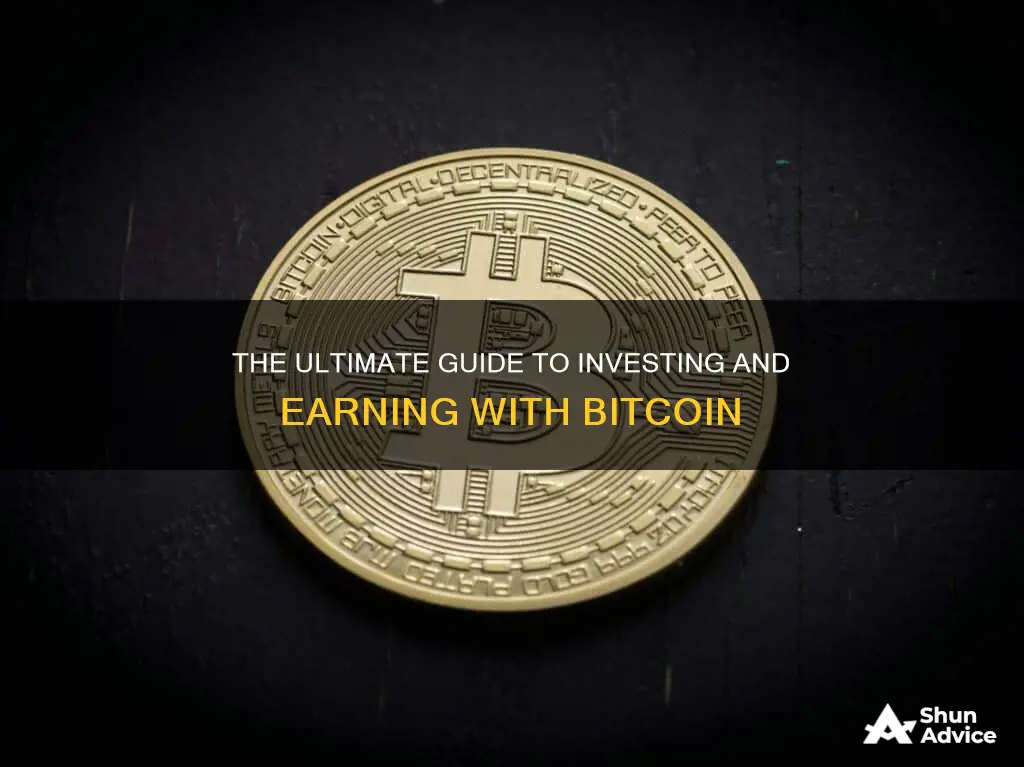
Bitcoin is a popular type of cryptocurrency that utilizes a large chain of interconnected computers to store and protect your digital assets. Bitcoin is a highly volatile asset that's prone to large and fast swings in value, which presents an opportunity for large returns but also poses tremendous risk. It is critical that you learn how to invest in Bitcoin responsibly before making any decisions.
1. Pick a Broker or Cryptocurrency Exchange: You can either go through a broker or a cryptocurrency exchange. Examples of brokers include Robinhood and SoFi, while examples of cryptocurrency exchanges include Coinbase, Gemini, and Binance.US.
2. Set Up an Account: You will need to create an account and provide personal information to prove your identity.
3. Add Funds to Invest: You can add funds to your account through various methods, including connecting it to your bank, initiating a wire transfer, or using a debit or credit card for payment.
4. Initiate Your Cryptocurrency Transaction: Once your account is funded, decide on the cryptocurrency you wish to buy and enter its symbol and the quantity of coins you want to purchase.
Remember to always do your research and only invest what you can afford to lose.
| Characteristics | Values |
|---|---|
| How to buy Bitcoin | Via a cryptocurrency exchange, a traditional stockbroker, a money transfer app, a Bitcoin ATM, or a Bitcoin ETF |
| What you need to buy Bitcoin | Personal identification documents, bank account information, and a secure internet connection |
| Bitcoin storage | In a hot wallet (online) or a cold wallet (offline) |
| Risks | Very high volatility, potential for fraud, vulnerable to hacking, lack of government regulation |
| Tips for investing in Bitcoin | Understand your risk tolerance, diversify your portfolio, start small, time the market |
What You'll Learn

Understand the risks
Bitcoin is a very high-risk investment. It is a volatile asset, meaning its value can rise or fall dramatically in a very short period. Its value is not linked to any physical asset, like gold or silver, and there is no central regulator to stabilise its price. Instead, the value of Bitcoin depends on market demand. When more people are buying Bitcoin, the value increases, and when fewer people are buying, the value decreases.
Because of this volatility, there is no guarantee that you will make money investing in Bitcoin. For example, if you had bought a bitcoin on December 17, 2017, it would have cost you over $20,000. But if you had tried to sell it just a week later, on December 24th, the most you could have got for it was $14,626.
As well as the unpredictable market, there are several other risks to be aware of when investing in Bitcoin:
- Cyberattacks and hacking – Bitcoin is vulnerable to cyberattacks, and there is no way to retrieve your coins if they are lost or stolen.
- Fraud – There is a lot of fraud in the Bitcoin market, with fake exchanges duping investors out of their money.
- Lack of regulation – Bitcoin is not currently regulated by governments or financial authorities, which could cause problems in the future if it becomes more widely used.
- Technology reliance – Bitcoin is entirely reliant on technology. If something goes wrong, or the technology becomes outdated, your investment could be lost.
- Block withholding – Bitcoin is created by solving mathematical equations, but a small group of people can use computational power to hide new blocks from honest miners, allowing them to reap all the benefits.
- Legal status – The legal status of Bitcoin is still unclear, and requirements for reporting holdings can be confusing.
- Taxes – In the US, profits from Bitcoin are taxable as capital gains, and the requirements for reporting these profits are strict.
- Pump-and-dump schemes – Predatory investors may convince amateurs to invest large amounts in Bitcoin, causing a surge in prices. They then sell all their holdings before the buying surge ends, making a huge profit, while the price of Bitcoin collapses.
The Ultimate Guide to Investing Bitcoin Futures
You may want to see also

Research the market
Before investing in Bitcoin, it is important to research the market and understand the risks and potential rewards. Here are some key things to consider:
Volatility
Bitcoin and other cryptocurrencies are highly volatile assets, prone to large and fast swings in value. This presents an opportunity for large returns but also poses tremendous risk. It is critical to understand this volatility and carefully assess your risk tolerance before investing.
Regulatory Landscape
The regulatory landscape for cryptocurrency is constantly evolving. Cryptocurrencies are generally not backed or regulated by a central authority like a government, which can make them more vulnerable to security breaches and scams. It is important to stay informed about the legal, regulatory, and tax status of Bitcoin in your jurisdiction.
Investment Strategies
There are different investment strategies you can consider when investing in Bitcoin. These include buying and holding for the long term, trading on short-term volatility, or using a combination of both approaches. Diversifying your portfolio by investing in a range of cryptocurrencies and other assets can also help manage risk.
Fundamental Analysis
It is important to understand the fundamentals of Bitcoin and the cryptocurrency market before investing. This includes analysing the blockchain technology, the investment thesis, consensus mechanism, and use cases for each cryptocurrency. Conducting thorough research and due diligence can help you make more informed investment decisions.
Market Trends
Keeping up with market trends and news can provide insights into the direction of the Bitcoin market. Following the movements of high-profile individuals and businesses, such as Elon Musk and Tesla, can also be informative. Monitoring adoption rates, trading volumes, and price movements can help identify potential opportunities or risks.
Expert Opinions
Seeking out the opinions of experts in the field can provide valuable insights. Consider the views of analysts, investors, and industry participants to gain a broader perspective on the market. This can help you identify potential risks and opportunities that may impact your investment decisions.
Smart Ways to Invest 50 Dollars in Bitcoin
You may want to see also

Choose a broker or exchange
Choosing a broker or exchange is an important step in investing in Bitcoin. There are two main options: a cryptocurrency broker or a cryptocurrency exchange. Both act as a gateway to the crypto market, but there are some key differences to be aware of.
Cryptocurrency Broker
A cryptocurrency broker is a firm or individual that acts as an intermediary between buyers and sellers of cryptocurrencies. They are similar to traditional stockbrokers and can provide a more convenient and secure option for beginners. Brokers usually offer an easy-to-use platform, with set prices and fees, and may also provide additional services such as holding cryptocurrencies for their customers and offering trading advice.
The main disadvantage of brokers is that they often charge higher fees than exchanges, and you may have less control over your investment moves. It's also important to choose a reputable broker with good security measures in place, as there is a risk of losing your funds to unreliable or fake brokers.
Cryptocurrency Exchange
A cryptocurrency exchange is a platform that allows users to buy, sell, and trade cryptocurrencies directly with each other, based on current market prices. Exchanges usually offer a wider range of cryptocurrencies and trading pairs than brokers, and they tend to have higher liquidity due to larger trading volumes.
The main disadvantages of exchanges are the potential security risks and the fact that they may be less regulated than brokers. Fees can also be a factor, as exchanges typically charge transaction fees which can add up, especially for larger trades.
The right choice for you will depend on your level of experience and your specific needs as an investor. Brokers are generally considered a better option for beginners, as they are usually safer and can provide more support and guidance. Exchanges, on the other hand, offer more direct trading and are often preferred by more experienced traders. It's important to do your research and choose a reputable and secure platform that meets your specific needs, whether that's a wide range of cryptocurrencies, low fees, or advanced trading features.
Exploring My Bitcoin Investments: How Much Have I Invested?
You may want to see also

Set up an account
Setting up an account to invest in Bitcoin is a relatively straightforward process. Here's a detailed, step-by-step guide on how to do it:
Choose a Cryptocurrency Exchange:
First, decide on a cryptocurrency exchange that suits your needs. Popular options include Coinbase, Binance, Kraken, and Gemini. These exchanges act as middlemen for cryptocurrency investing, similar to a stock brokerage. Consider factors such as security, fees, trading volume, minimum investment requirements, and the types of cryptocurrencies available when making your decision.
Sign Up and Create an Account:
Once you've selected your preferred exchange, it's time to create an account. This typically involves signing up and providing personal information to verify your identity, such as your name, email address, and password. You may also need to provide proof of identity, such as a driver's license or passport, as part of the exchange's "Know Your Customer" (KYC) protocols.
Connect Your Bank Account:
To fund your cryptocurrency purchases, you'll need to link your bank account to your exchange account. This can usually be done by providing your bank account information during the account setup process. Alternatively, you can connect your debit or credit card for payment.
Add Funds to Your Account:
Before investing in crypto, ensure you have sufficient funds in your account. You can add money through various methods, including bank transfers, wire transfers, or using a debit or credit card for payment. Keep in mind that using a credit card for crypto purchases may result in higher interest rates and additional fees.
Set Up Two-Factor Authentication:
To enhance the security of your account, it's recommended to set up two-factor authentication. This adds an extra layer of protection, making it more difficult for unauthorized users to access your account.
Explore Wallet Options:
When investing in Bitcoin, you'll need to decide how you want to store your cryptocurrency. You can choose between a "hot wallet" or a "cold wallet." A hot wallet is connected to the internet and provided by either your exchange or a third-party provider. While convenient, hot wallets are more susceptible to hacking. On the other hand, a cold wallet is a physical device, like a USB drive, that stores your cryptocurrency offline, providing an extra layer of security.
Initiate Your First Cryptocurrency Purchase:
With your account set up and funded, you're now ready to make your first Bitcoin purchase. Decide on the amount of Bitcoin you want to buy, keeping in mind that many exchanges allow you to purchase fractional shares of cryptocurrencies due to their high value.
Remember to always do your research, understand the risks involved, and invest responsibly. Cryptocurrency investments can be volatile, so it's important to carefully consider your financial situation and risk tolerance before diving into the world of Bitcoin investing.
Why Bitcoin Belongs in Your Investment Portfolio
You may want to see also

Add funds
Adding funds to your Bitcoin wallet is simple. All you need is your wallet address, which you give to your exchange to send the funds to. This is a very important step to securing your investment in cryptocurrency.
You should never leave your Bitcoin on an exchange unless you are going to sell it immediately. Instead, you should send your money to an exchange, purchase your crypto, and then withdraw the coins immediately to a secure hardware wallet.
- Select your exchange: Choose a trustworthy and low-cost exchange, such as Coinbase, to send your funds to. Compare the fees charged by different exchanges for converting your fiat currency to Bitcoin.
- Get a Bitcoin wallet: You can't get cryptocurrency without a crypto wallet. There are many different types of wallets to choose from, including online ("hot") wallets, offline ("cold") wallets, hardware wallets, and paper wallets. Research which wallets support each crypto, read reviews, and then download the wallet or wallets of your choice.
- Place an order: Sign up or log in to your chosen exchange and place an order for the amount of crypto you want to buy.
- Enter your wallet address: To transfer Bitcoin to your wallet, you will need to enter your public key or wallet address. This is a long string of numbers and letters that others can see, and which appears on the blockchain.
- Confirm your wallet address: Double-check that the wallet address you have entered is correct. If you send your Bitcoin to the wrong address, there is no way of getting your money back.
- Wait for confirmation: It can take around 10 minutes to get one confirmation on the blockchain. For payments over $10,000, it is recommended to wait for six confirmations, which should take around one hour.
And that's it! You now know how to add funds to your Bitcoin wallet.
Strategic Company Investments with Bitcoin
You may want to see also
Frequently asked questions
Cryptocurrency is a risky investment, so approach it with your eyes open to potential pitfalls. Digital currency is volatile, largely unregulated, and there are many unknowns about how this new form of currency will develop in the future.
Never invest more than you can afford to lose. It is recommended to hold no more than 2% of your overall portfolio in any one cryptocurrency to limit crypto-specific risks.
Blockchain is a kind of database that records and timestamps every entry into it. The best way to think of a blockchain is like a running receipt of transactions. When a blockchain database powers cryptocurrency, it records and verifies transactions in the currency, verifying the currency’s movements and who owns it.
If you’re looking to invest in Bitcoin, you have a variety of ways to do so, and you can work with a number of companies, including crypto exchanges, traditional brokers, and financial apps.







